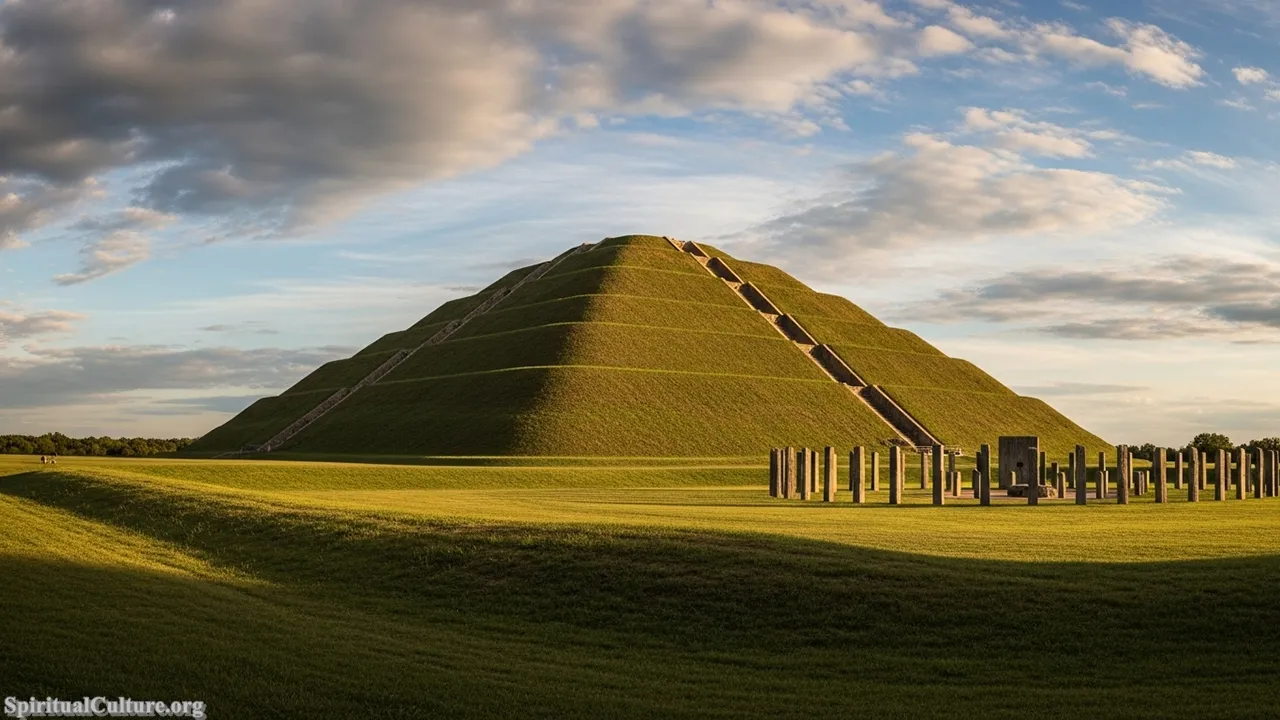The mosque, or masjid, meaning ‘place of prostration,’ is far more than a structure for congregational prayer; it is the spiritual and cultural heart of the Muslim world. From the simple, open-air courtyard of the Prophet’s house in Medina to the colossal modern marvels of the 21st century, each mosque is a chapter in the global story of Islamic civilization. They stand as enduring symbols of faith, learning, and community, encapsulating the artistic and engineering prowess of diverse empires.
At Spiritual Culture, we understand that true ‘fame’ is not measured by size alone. It is defined by historical impact, the depth of spiritual reverence, and the mosque’s continuing role as a living heritage site. The mosques in this ranking have acted as centers of governance, education (such as the origins of Al-Azhar University), and monumental architectural innovation that transcends regional styles.
This authoritative Top 10 list is based on reasoned, evidence-based cultural and spiritual criteria, prioritizing a mosque’s sanctity within the Islamic faith, its verified historical age and influence (such as being a former Qibla or an imperial centerpiece), and its recognised international heritage status. Prepare for a reflective journey through the sanctuaries that define the spiritual geography of the world.
Table of the Top 10 World Mosques with the Greatest Spiritual and Historical Influence
| Rank | Mosque Name | Location | Primary Significance | Construction/Founding | Cultural/Spiritual Status (As of Current Time) |
|---|---|---|---|---|---|
| 1 | Masjid al-Haram (The Great Mosque of Mecca) | Mecca, Saudi Arabia | Holist site in Islam; surrounds the Kaaba and the Zamzam Well. | Pre-Islamic origins; Current structure continually expanded (7th Century onward) | The Ultimate Qibla; Focal point of Hajj and Umrah pilgrimages. |
| 2 | Al-Masjid an-Nabawi (The Prophet’s Mosque) | Medina, Saudi Arabia | Second holiest site; built by the Prophet Muhammad; contains his tomb. | 622 CE (Original founding) | Pilgrimage destination; Houses the Rawdah Ash-Sharifah (Noble Garden). |
| 3 | Al-Aqsa Mosque/Haram al-Sharif Complex | Jerusalem, Palestine | Third holiest site; believed to be the destination of the Prophet’s Night Journey (Isra). | 705 CE (Al-Aqsa Mosque); Complex pre-dates Islam. | Site of the first Qibla; Critical geopolitical and spiritual nexus. |
| 4 | Umayyad Mosque (Great Mosque of Damascus) | Damascus, Syria | Oldest stone mosque still standing; Imperial center of the Umayyad Caliphate. | 705–715 CE | UNESCO World Heritage Site (as part of Ancient City of Damascus); Center of Islamic and early Christian history. |
| 5 | Great Mosque of Córdoba (Mezquita-Cathedral) | Córdoba, Spain | Masterpiece of Moorish architecture; Symbol of Islamic Golden Age in Al-Andalus. | 785 CE (Original mosque) | UNESCO World Heritage Site; Testament to inter-cultural history and architectural ingenuity. |
| 6 | Sultan Ahmed Mosque (Blue Mosque) | Istanbul, Turkey | Pinnacle of Ottoman classical architecture; Symbolic counterpoint to Hagia Sophia. | 1609–1616 CE | UNESCO World Heritage Site (as part of Historic Areas of Istanbul); Iconic spiritual landmark of Istanbul. |
| 7 | Al-Azhar Mosque | Cairo, Egypt | Spiritual and intellectual heart of the Sunni world; Birthplace of Al-Azhar University. | 970 CE | Oldest continuously operating university in the world; Global center for Islamic learning. |
| 8 | Great Mosque of Djenné | Djenné, Mali | Largest mud-brick building in the world; Iconic example of Sudano-Sahelian architecture. | 13th century (Current structure 1907) | UNESCO World Heritage Site; Represents traditional, earth-based African Islamic heritage. |
| 9 | Badshahi Mosque | Lahore, Pakistan | Mughal architectural masterpiece; One of the largest mosques from the Mughal Empire. | 1673 CE | One of Pakistan’s most famous landmarks; Reflects the zenith of Mughal spiritual and political power. |
| 10 | Sheikh Zayed Grand Mosque | Abu Dhabi, UAE | Modern masterpiece; Symbol of contemporary Islamic architecture, inclusiveness, and cultural dialogue. | 1996–2007 CE | One of the largest in the world; Combines global Islamic architectural styles and artistry. |
#10. Sheikh Zayed Grand Mosque, Abu Dhabi, UAE
The Sheikh Zayed Grand Mosque in Abu Dhabi is a spectacular entry, representing the synthesis of classical Islamic design with 21st-century opulence and engineering. Completed in 2007, it stands as a testament to the UAE’s commitment to fostering a cultural and spiritual center that welcomes the world. Its sheer scale and the pristine white marble structure, adorned with floral motifs and semi-precious stones, instantly established it as one of the most recognizable mosques on the planet as of the Current Time of Writing.
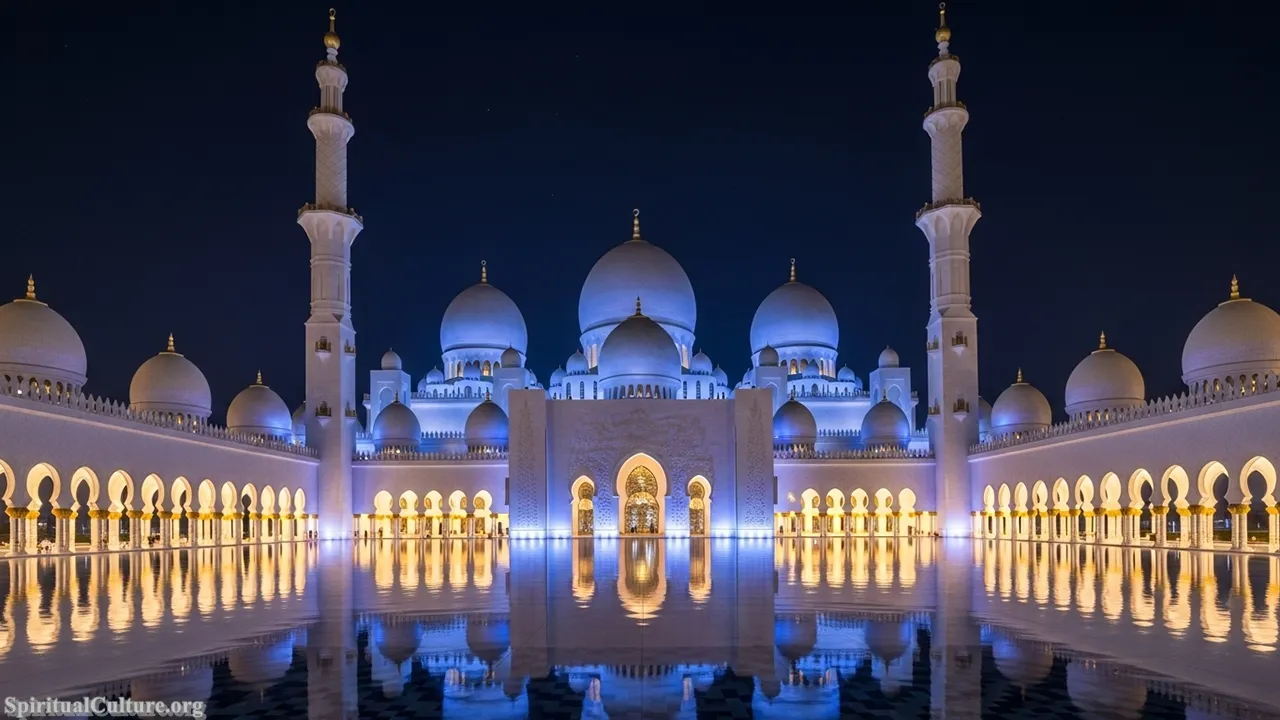
Its significance goes beyond its status as one of the world’s largest mosques, capable of accommodating over 40,000 worshippers. The mosque was conceived as a structure to unify the cultural diversity of the Islamic world, incorporating design elements from Persian, Mughal, and Moorish architecture. This intentional blend gives it a profound spiritual impact, emphasizing inclusivity and peace, making it a powerful modern symbol of global Islamic unity and dialogue.
The final spiritual lesson offered by this modern marvel is the power of contemporary creation to respect and elevate tradition. The mosque’s commitment to using the highest-quality materials, including the world’s largest hand-knotted carpet and colossal crystal chandeliers, demonstrates a celebratory investment in faith. Its preservation value lies in its role as a living template for how future religious architecture can embrace majesty while remaining a sincere place of contemplation.
Cultural/Spiritual Highlights:
- Named after the UAE’s founding father, Sheikh Zayed bin Sultan Al Nahyan.
- Features 82 domes and over 1,000 columns in pure white marble.
- Consciously blends architectural styles from Iran, Pakistan, Morocco, and Egypt.
- A major global hub for interfaith and cultural exchange.
#9. Badshahi Mosque, Lahore, Pakistan
Commissioned by the Mughal Emperor Aurangzeb and completed in 1673, the Badshahi Mosque in Lahore represents the zenith of Mughal architectural ambition in South Asia. For centuries, its massive red sandstone walls and expansive courtyard dominated the skyline of Lahore, capable of holding up to 100,000 worshippers. As a historical relic of the Mughal Empire, it holds profound cultural importance for Pakistan and the entire subcontinent, representing a glorious era of spiritual and artistic patronage.
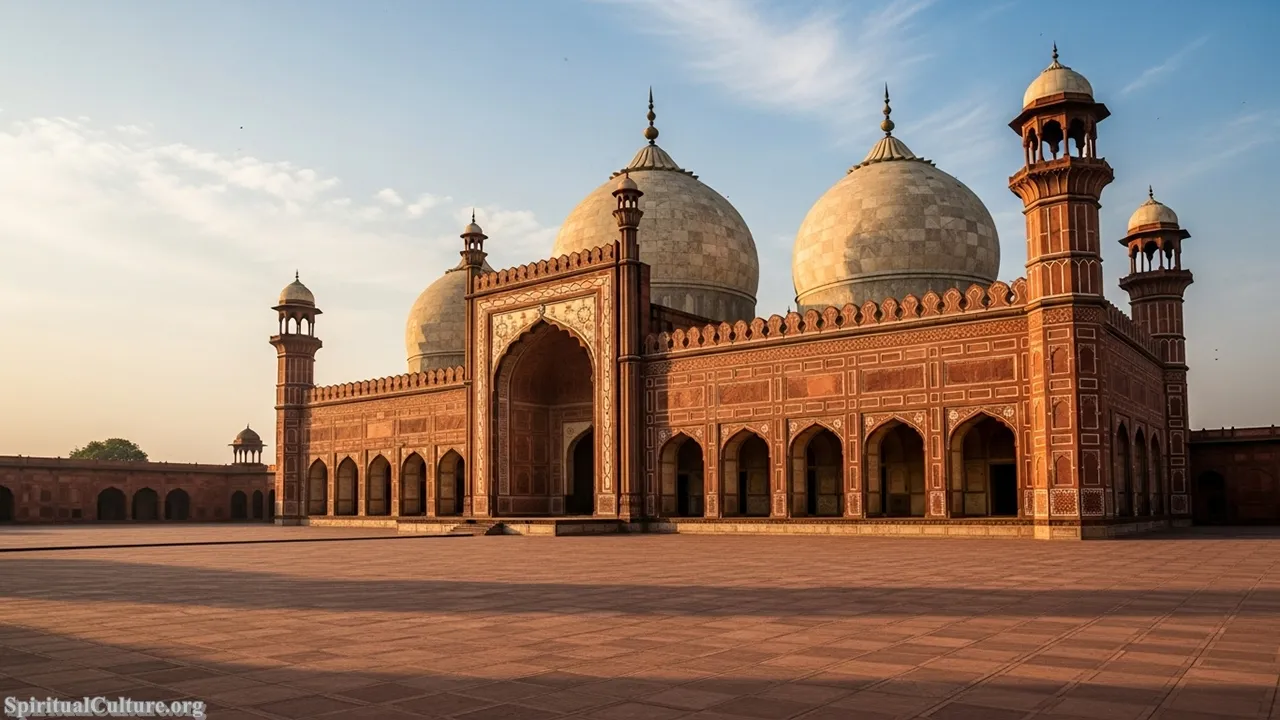
The spiritual impact of the Badshahi Mosque is tied intrinsically to the expression of imperial piety. It was built to reflect the vast power and deep devotion of the Mughal Caliphate, following in the tradition of the Jama Masjid in Delhi but with an even more imposing scale. The sheer volume and geometric perfection of its construction were intended to evoke awe and inspire reverence, ensuring that the act of prostration within its walls felt connected to the highest level of worldly authority and divine decree.
Today, the mosque serves as a powerful reminder of the sophisticated and syncretic culture that flourished under the Mughals. Its continued use as a congregational mosque underscores the resilience of spiritual heritage against the march of time. Its preservation value is critical, symbolizing the depth of Islamic art and architecture east of Persia and serving as a key national emblem of faith and history for Pakistan.
Cultural/Spiritual Highlights:
- Mughal architectural masterpiece built by Emperor Aurangzeb.
- Courtyard once served as the largest capacity mosque in the world.
- Its design greatly influenced later South Asian mosques.
- Houses relics associated with the Prophet Muhammad and his cousin, Ali.
#8. Great Mosque of Djenné, Djenné, Mali
A staggering testament to traditional earth-based construction, the Great Mosque of Djenné, first erected in the 13th century (with the current structure dating to 1907), is the largest mud-brick building in the world. Located in the flood plains of the Bani River, the mosque’s unique Sudano-Sahelian style, characterized by three massive towers and clustered columns, stands as a vibrant beacon of African Islamic architecture. It is the architectural centerpiece of the Historic Town of Djenné, recognized globally as of the Current Time of Writing.
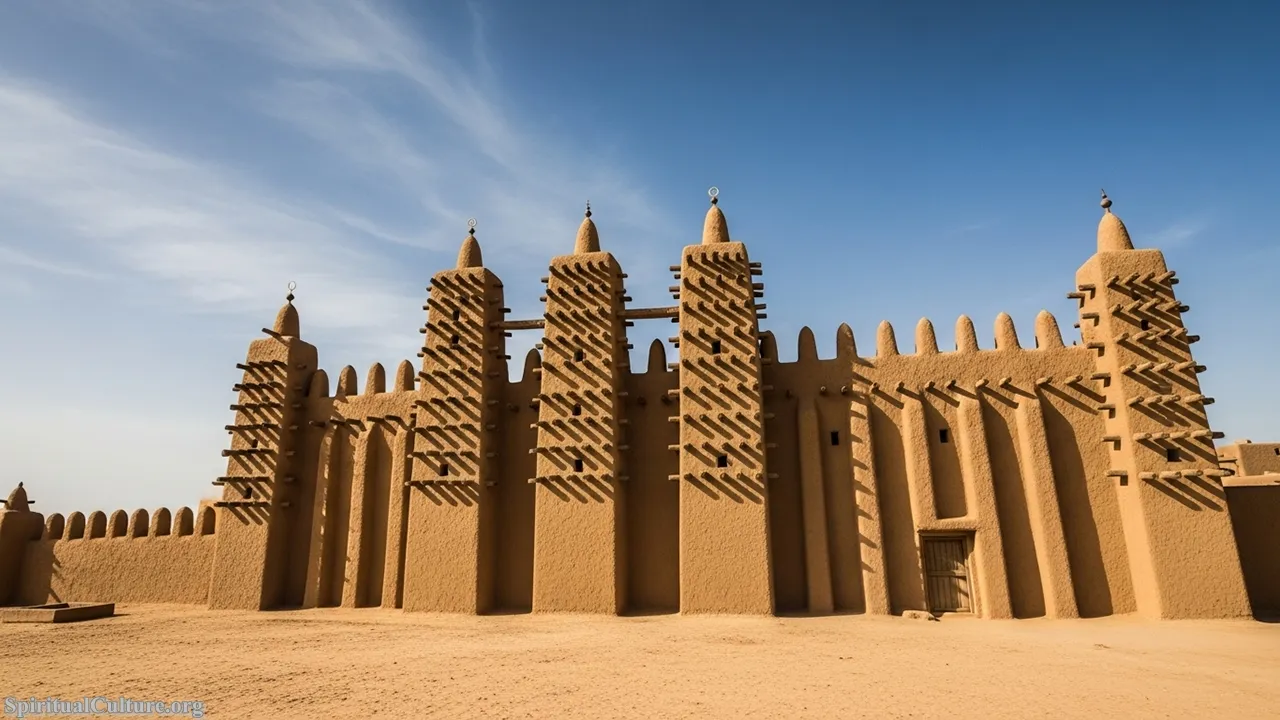
The mosque’s spiritual significance is uniquely intertwined with its community and environment. Its annual re-plastering, a communal festival known as the Crépissage, transforms maintenance into a profound, unifying spiritual event, fostering deep communal cohesion and shared responsibility for the sacred space. This annual ritual highlights a deep-seated spiritual impact, showing that the house of God is sustained not by endless wealth, but by the physical, collective effort of its devoted adherents.
The moral lesson of the Great Mosque of Djenné is one of harmonious adaptation and sustainable faith. Its earthen construction teaches that the most sacred spaces can be built from the most humble, locally available materials. As a UNESCO World Heritage Site, its preservation is crucial, offering the world an invaluable example of indigenous cultural heritage seamlessly merging with the universality of Islamic principles.
Cultural/Spiritual Highlights:
- The largest mud-brick building in the world.
- UNESCO World Heritage Site (as part of the Historic Town of Djenné).
- Annual re-plastering festival (Crépissage) is a unique, unifying communal tradition.
- Pinnacle of the distinctive Sudano-Sahelian architectural style.
#7. Al-Azhar Mosque, Cairo, Egypt
Founded in 970 CE by the Fatimid Caliphate, Al-Azhar Mosque in Cairo quickly evolved from a Friday congregation mosque into the spiritual and intellectual heart of the Sunni Islamic world. It is the birthplace of Al-Azhar University, which remains the oldest continuously operating university globally, making the mosque’s historical significance immense. For over a millennium, it has been the epicenter for Islamic law, theology, and the Arabic language, powerfully shaping global Muslim thought and practice as of the Current Time of Writing.
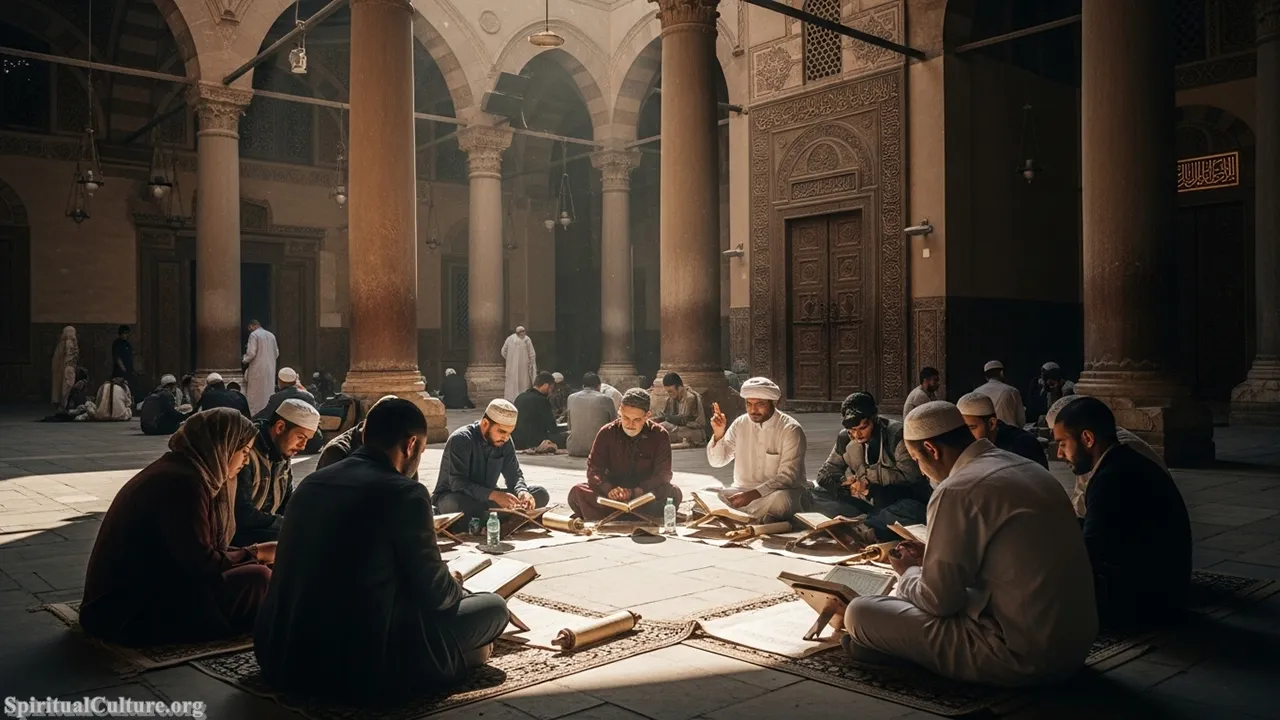
The mosque’s ranking is driven by its colossal intellectual and spiritual impact. Its courtyards and halls have educated generations of scholars, imams, and leaders, disseminating a specific, moderate school of Islamic thought across the Middle East, Africa, and Asia. The spiritual depth of Al-Azhar comes from its identity as a perennial source of knowledge, where praying in its ancient halls is a direct connection to a thousand-year chain of scholarship and learning that began just decades after the major Islamic conquests.
The preservation value of Al-Azhar lies in its monumental contribution to the human heritage of education. It is not just a building, but a perpetual institution symbolizing the foundational Islamic reverence for knowledge (ilm). Its continued role as a university reinforces the moral lesson that the pursuit of understanding is inseparable from spiritual devotion, ensuring its legacy remains dynamic and relevant to the contemporary world.
Cultural/Spiritual Highlights:
- Founded in 970 CE by the Fatimid Dynasty.
- The oldest continuously operating university in the world originated here.
- Global spiritual and intellectual center of Sunni Islamic jurisprudence.
- Features architecture reflecting Fatimid, Mamluk, and Ottoman styles.
#6. Sultan Ahmed Mosque (Blue Mosque), Istanbul, Turkey
Standing regally in Istanbul, the Sultan Ahmed Mosque, known universally as the Blue Mosque for the exquisite blue Iznik tiles adorning its interior, is an iconic landmark of Ottoman classicism. Commissioned by Sultan Ahmed I and completed between 1609 and 1616, it was designed to be a definitive spiritual and architectural statement, symbolizing the power and piety of the Ottoman Empire. Its six minarets—a controversial feature at the time, as it matched the number at the Kaaba—cemented its place as a monumental piece of global Islamic heritage.
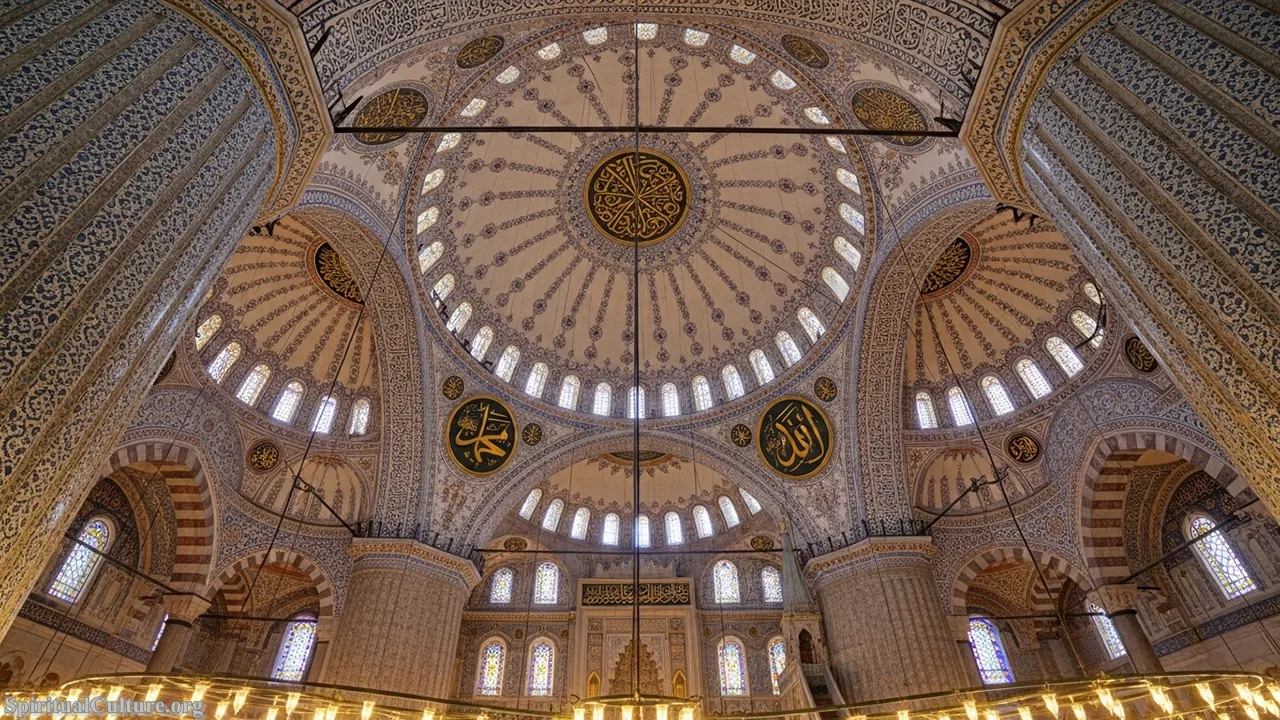
The spiritual impact of the Blue Mosque is derived from its audacious ambition to rival the structural and historical grandeur of the nearby Hagia Sophia. Its location, facing that Byzantine masterpiece, embodies a spiritual dialogue between two dominant world faiths and imperial histories. The soaring domes, the cascading semi-domes, and the light streaming through the stained glass create a profoundly contemplative atmosphere, channeling Ottoman political strength directly into a sacred space dedicated to the Divine.
This mosque serves as a magnificent reflection on the beauty and legacy of Islamic art and patronage. It is a UNESCO World Heritage Site (as part of the Historic Areas of Istanbul), underscoring its pivotal role in the urban, spiritual, and artistic identity of one of the world’s most historically significant cities. The blend of artistry and faith found here offers a lasting lesson in constructing beauty as an act of worship.
Cultural/Spiritual Highlights:
- Pinnacle of classical Ottoman architecture and Mimar Sinan’s school.
- Famous for its interior covered in over 20,000 blue Iznik tiles.
- Unique for having six slender minarets.
- UNESCO World Heritage Site (part of Historic Areas of Istanbul).
#5. Great Mosque of Córdoba (Mezquita-Cathedral), Córdoba, Spain
The Great Mosque of Córdoba, originally built from 785 CE onward by the Umayyad ruler Abd al-Rahman I, represents the single greatest surviving example of the spiritual and cultural achievements of Islamic civilization in Western Europe (Al-Andalus). Its vast, mesmerizing forest of columns and arches, made of jasper, onyx, marble, and granite, showcases an architectural vision unmatched in its era. Its history—built on a Visigothic church, later consecrated as a Catholic cathedral—makes it a profoundly unique site of inter-cultural and spiritual layering as of the Current Time of Writing.

Its reason for high ranking is purely due to its historical and spiritual symbolism. It was the premier spiritual center of the Caliphate of Córdoba, the intellectual and cultural capital of medieval Europe. The architectural ingenuity, particularly the stunning mihrab, projects a spiritual impact emphasizing light, infinity, and complexity, a physical manifestation of scholarly excellence and divine unity. It is a poignant, living testament to a time when Islamic science and art led the Western world.
The site’s preservation is paramount as a UNESCO World Heritage Site, serving as a vital moral lesson on the cycles of history and the mingling of civilizations. It forces a reflection on how sacred spaces can contain multiple narratives without erasing their past. The mosque-cathedral compels visitors to recognize the deep spiritual and cultural contribution of Al-Andalus to the modern European identity.
Cultural/Spiritual Highlights:
- Over 850 columns forming a breathtaking “forest” of double arches.
- Premier spiritual and intellectual center of the Caliphate of Córdoba.
- UNESCO World Heritage Site and a key symbol of Al-Andalus heritage.
- The stunning, richly decorated horseshoe arch Mihrab.
#4. Umayyad Mosque (Great Mosque of Damascus), Damascus, Syria
The Umayyad Mosque, located in the heart of the Ancient City of Damascus, is one of the oldest and grandest mosques in the world, with its current structure completed between 705 and 715 CE. Built on a site that has been a place of worship for millennia—successively an Aramaean temple, a Roman temple (of Jupiter), and a Christian church (of John the Baptist)—the mosque’s deep historical layering is exceptional. Its architecture, featuring a massive courtyard and an impressive minaret (Minaret of Jesus), became a model for later Islamic architecture, particularly the hypostyle layout.

The mosque’s spiritual impact is profound, having served as the imperial center of the Umayyad Caliphate, the first great Muslim dynasty. Its hallowed ground includes a shrine believed to contain the head of John the Baptist (Prophet Yahya to Muslims), a unique point of veneration that links Islam with its Abrahamic predecessors. As a center of political and spiritual power for the first hundred years of the Islamic Golden Age, its historical gravity is second only to the Two Holy Mosques of Saudi Arabia.
Today, as a UNESCO World Heritage Site, the Umayyad Mosque stands as a sobering reflection on the continuity and fragility of human heritage in the face of conflict. Its enduring presence underscores the moral lesson that true spiritual centers transcend transient political and military struggles. Its preservation represents a commitment to protecting one of civilization’s most important religious and architectural milestones.
Cultural/Spiritual Highlights:
- Oldest stone mosque still standing in its original form.
- Built on the site of a former Roman temple and a Byzantine church.
- Contains a shrine venerated by both Muslims and Christians (head of John the Baptist).
- UNESCO World Heritage Site (as part of the Ancient City of Damascus).
#3. Al-Aqsa Mosque/Haram al-Sharif Complex, Jerusalem, Palestine
Al-Aqsa Mosque and the surrounding compound of Haram al-Sharif (The Noble Sanctuary), which includes the iconic Dome of the Rock, is the third holiest site in Islam. Located in the Old City of Jerusalem, a city revered by all three major Abrahamic faiths, the complex’s historical significance is immeasurable. The Al-Aqsa Mosque building itself was completed in 705 CE, but the complex’s sanctity is tied to the very earliest moments of the faith, making it a critical nexus of global religious heritage as of the Current Time of Writing.

Its spiritual ranking is immutable, derived from its association with the Prophet Muhammad’s miraculous Night Journey (Isra’), where he is believed to have travelled from Mecca to Al-Aqsa before ascending to heaven (Mi’raj). Furthermore, it was the first Qibla (direction of prayer) for Muslims before the focus shifted to the Kaaba in Mecca. The spiritual impact of Al-Aqsa is one of primordial connection, serving as a powerful geographical link between the early Prophets and the final message of Islam, cementing its status as a site of profound veneration.
The moral lesson drawn from Al-Aqsa is the immense responsibility that comes with shared sacred space. Its preservation is a global cultural and spiritual imperative, symbolizing the confluence of historical narratives and faith. It compels humanity to pursue peace and mutual respect to ensure the sanctity and spiritual integrity of this foundational holy site for future generations.
Cultural/Spiritual Highlights:
- The third holiest site in all of Islam.
- The site of the first Qibla (direction of prayer).
- Believed to be the destination of the Prophet Muhammad’s Night Journey.
- The compound contains the iconic Dome of the Rock.
#2. Al-Masjid an-Nabawi (The Prophet’s Mosque), Medina, Saudi Arabia
Al-Masjid an-Nabawi, the Prophet’s Mosque, holds the unparalleled position of being the second holiest site in Islam. Established by the Prophet Muhammad himself upon his migration (Hijra) to Medina in 622 CE, the original structure was a simple, open-air space that served as the center of the earliest Muslim community. The mosque today is a sprawling, architecturally magnificent complex that encompasses the final resting place of the Prophet Muhammad, marked by the iconic Green Dome, and his two closest companions.

The spiritual impact of this mosque is immediate and deeply personal for Muslims, as it represents the physical location of the Prophet’s life, teachings, and governance. A section of the mosque, known as the Rawdah Ash-Sharifah (The Noble Garden), is considered by believers to be a piece of Paradise and is a highly sought-after place for prayer. Its continuous expansion over 14 centuries, culminating in a state-of-the-art facility accommodating over a million worshippers, reflects the enduring devotion and reverence for the Messenger of God.
The preservation of Al-Masjid an-Nabawi is absolute and ensures that the core of the Islamic community’s history remains intact. Its moral lesson lies in its origin: a humble community center built by hand that grew into a global spiritual beacon. It teaches that true greatness and influence emerge from sincere, communal piety and the foundational vision of a prophet.
Cultural/Spiritual Highlights:
- The second holiest site in Islam.
- Founded and built by the Prophet Muhammad in 622 CE.
- Contains the tomb of the Prophet Muhammad under the Green Dome.
- The Rawdah Ash-Sharifah is considered a highly blessed piece of Paradise.
#1. Masjid al-Haram (The Great Mosque of Mecca), Mecca, Saudi Arabia
Masjid al-Haram is, unequivocally, the most famous mosque in the world, holding the ultimate spiritual and historical primacy in Islam. It is the holiest site on Earth for all Muslims, as it encircles the Kaaba—the cubic structure believed to have been built by the Prophet Ibrahim (Abraham) and his son Ismail (Ishmael)—which serves as the Qibla, the direction of prayer, for every Muslim worldwide. Its current form is the culmination of continuous expansion over 14 centuries to accommodate the millions of pilgrims who visit annually for Hajj and Umrah.

The reason for its unassailable number one ranking is its singular, non-negotiable spiritual impact. It is the sacred focal point toward which the entire global Muslim community turns five times a day, forging an unparalleled, tangible unity across all borders and cultures. It contains not only the Kaaba, but also the Maqam Ibrahim (Station of Abraham) and the sacred Zamzam Well, embodying foundational stories of Abrahamic faith that pre-date Islam and are central to its narrative.
The final reflection offered by Masjid al-Haram is the profound moral lesson of human equality and submission. During Hajj and Umrah, millions of pilgrims, regardless of wealth, race, or status, stand shoulder-to-shoulder, wearing the same simple cloth, performing the same rituals around the Kaaba. This universal, collective act of worship is the highest expression of cultural and spiritual unity found in the world, making its preservation a divine and human imperative.
Cultural/Spiritual Highlights:
- The holiest site in Islam, serving as the universal Qibla.
- Encloses the Kaaba, the spiritual center of the Islamic faith.
- Focal point for the Hajj and Umrah pilgrimages, uniting millions annually.
- Contains the Maqam Ibrahim and the sacred Zamzam Well.
Conclusion
The Top 10 Most Famous Mosques in the World are not mere buildings; they are monumental witnesses to the resilience, spread, and diversity of a global spiritual tradition. From the sacred core of Mecca and Medina to the earthen wonder of Djenné and the imperial grandeur of Istanbul, each structure in this Spiritual Culture guide is a repository of history, architecture, and profound devotion. They remind us that the spiritual impulse to gather, to learn, and to prostrate before the Divine is a universal force that transcends epochs.
As we celebrate these sanctuaries in the Current Time of Writing, we celebrate the human capacity to imbue spaces with transcendent meaning. They stand as calls for peace, centers of knowledge, and everlasting symbols of the unifying power of faith. May their domes and minarets continue to inspire contemplation and a deeper appreciation for the rich cultural tapestry of the world.


